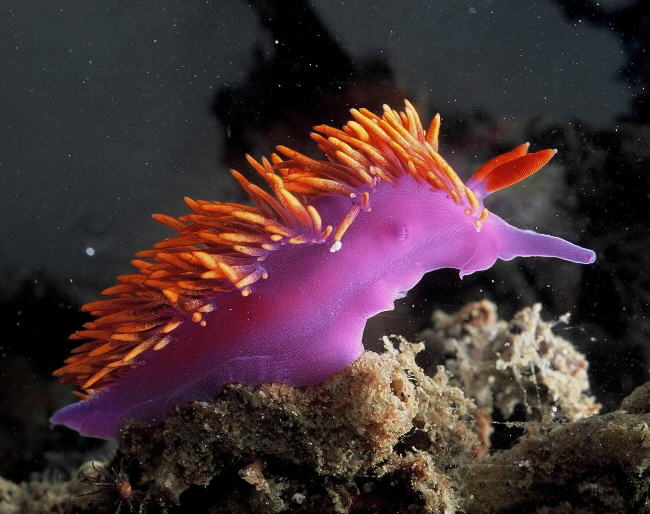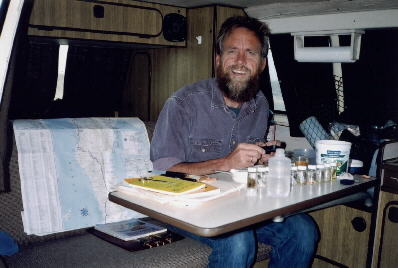 |
Photo courtesy of Todd C. Huspeni of UCSB
Specimen collected off off Goleta, California
Flabellina iodinea
Flabellina iodinea (Cooper, 1862)
Flabellina iodinea is one of the most visually stunning and common aeolids in southern and central California. It has been reported from off of Punta Asuncion, Baja California Sur, Mexico (Mulliner, 1982) to Vancouver Island, British Columbia (Bernard, 1970), but is rare north of San Francisco and has never been collected from the outer coast of Oregon and Washington. Flabellina iodinea has also been found at sites scattered throughout the Gulf of California, especially in deeper or colder waters (Bertsch & Kerstitch, 1984), and in the Galapagos Islands (Gosliner, 1991).
Flabellina iodinea prey selectively on the orange polyps of the athecate hydroid Eudendrium ramosum (Engel, 1976; McDonald & Nybakken, 1978; personal observations). McBeth (1972) showed that the purple pigment in the body of F. iodinea, the orange color in its cerata, and the scarlet red in its rhinophores are all derived from a single carotenoid pigment, astaxanthin, obtained from its hydroid prey. In the aeolid, this pigment occurs in three slightly different states, resulting in the three distinct colors.
Flabellina iodinea lay bright pinkish orange colored egg ribbons, usually on the stalks of its hydroid prey. The eggs develop into planktotrophic veligers after 7 days at 14 degrees C (Engel, 1976; personal observations).
When disturbed by potential predators such as seastars, Flabellina iodinea can lift off the substratum and swim away by flexing its body strongly and gracefully from side to side. (MacFarland, 1966; Farmer, 1970; personal observations).
References:
Bernard, F. R. 1970. A distributional checklist of the marine molluscs of British Columbia: based on faunistic surveys since 1950. Syesis 3:75-94.
Bertsch, H. & A. Kerstitch. 1984. Distribution and radular morphology of various nudibranchs (Gastropoda: Opisthobranchia) from the Gulf of California, Mexico. The Veliger 26:264-273.
Engel, C. P. 1976. The biology and life history of the nudibranch Flabellinopsis iodinea (Cooper, 1863). Ph.D. Dissertation, University of California, Santa Barbara, California.
Farmer, W. M. 1970. Swimming gastropods (Opisthobranchia and Prosobranchia). The Veliger 13:73-89.
Gosliner, T. M. 1991. The opisthobranch gastropod fauna of the Galapagos Islands. Pp. 281-305 in M. J. James (ed.), Galapagos marine invertebrates: taxonomy, biogeography, and evolution in Darwin's islands. Plenum Press: New York.
McBeth, J. W. 1972. Carotenoids from nudibranchs. Comparative Biochemistry and Physiology 41(B):55-68.
MacFarland, F. M. 1966. Studies of opisthobranchiate mollusks of the Pacific coast of North America. Memoirs of the California Academy of Sciences 6:1-546.
McDonald, G.R. & J.W. Nybakken. 1978. Additional notes on the food of some California nudibranchs with a summary of known food habits of California species. The Veliger 21(1):110-119.
Mulliner, D. 1982. Personal notes, from Dave Mulliner. Opisthobranch Newsletter 14:2.
Webmaster's Note:
For those of you on Cable or DSL, you may want to take a look at a 3mg file of Flabellina Iodinea by Dr. Alan Grant that previewed a couple of weeks ago. It is well worth the download time if you haven't seen it yet! Click
here to begin the show!
Taxonomic Information courtesy of Dr. Jeff Goddard

|
Dr. Jeff Goddard |
